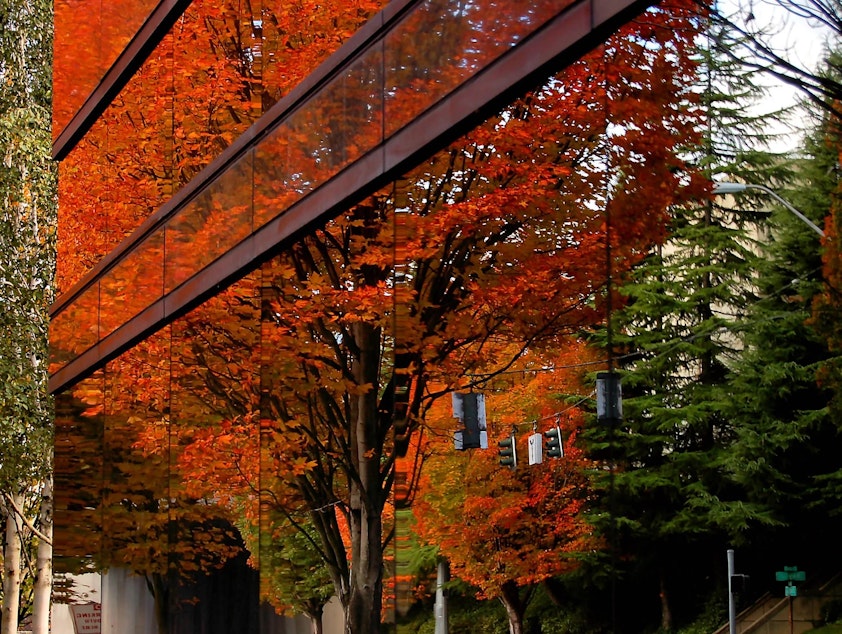As Seattle loses tree canopy, a city council bill may let developers cut down more

Developers and density advocates scored a potential victory from the Seattle City Council on Thursday. The council's Land Use Committee voted 4-1 to guarantee developers' rights to remove trees on lots slated for higher density development.
The complex legislation was first introduced by Mayor Bruce Harrell in March. It would allow “hardscape” — that's non-living landscaping elements like patios or walkways along with the building itself — to cover at least 85% of individual properties that have been zoned for low-rise development (townhomes) and above, regardless of existing tree cover. If, for example, a large tree would prevent developers from reaching that 85% hardscape threshold on a single property, the tree could be removed.
On Thursday, the Land Use Committee amended the legislation so that in higher density zones, developers are guaranteed the ability to develop 100% of the property.
Councilmember Alex Pedersen, who cast the lone vote against the ordinance, said those guarantees remove any incentive for developers to preserve existing trees. He said the current city policy, which is to consider the ratio of the building to the size of the lot, provides more flexibility to adapt construction around trees.
But architect David Nieman told the council during public comment that the new proposal reflects the reality that it's nearly impossible to save big trees in areas zoned for higher density. He said the city currently requires developers to document large trees on lots slated for multifamily housing projects, but in his experience, all the trees have ultimately been removed anyway.
“While we haven’t had a project that has saved any of these trees, it does require an enormous amount of analysis and effort to get to the point of proving the tree can’t be saved, while maintaining full development potential,” Nieman said.
Sponsored
Pedersen proposed an unsuccessful amendment that would have allowed the city to retain its current approach to development in low-rise zones.
“This may be the most important amendment all day,“ he said. “I’m worried that this 85% will actually make things worse for trees in Seattle.”
A recent study found that Seattle is losing tree canopy, and that less affluent neighborhoods had fewer trees to start with. Lower canopy is linked to heat islands in Seattle that see the hottest temperatures during record heat waves.
However, researchers also find that urban density can reduce the carbon emissions fueling climate change, and decrease development pressure on the outskirts of cities.
The Urban Forestry Commission, which is appointed by the council and mayor, recommended against the development guarantees, in part citing a lack of evidence to support how they'd work.
Sponsored
“This is a novel proposal, to the UFC’s knowledge, not tested in other jurisdictions. It is unclear how, in reality, this will serve to provide the clarity desired by builders or tree preservation as intended by these regulations,” the commission wrote in a letter addressed to the council last month.
Lia Hall is a community representative on the Urban Forestry Commission but spoke on her own behalf. She said the commission’s recommendations are “not measures to punish or make more difficult the lives of developers."
She added, "It's not a question of whether we can have affordable housing and trees — it's a design problem. Tree advocates fear a future that will be uninhabitable to all.”
The proposed regulations also include a new fee-in-lieu system that could fund tree planting elsewhere when trees are removed.
“We are incentivizing builders to protect these trees, because if they have to pay an in-lieu fee or a replacement, that’s cutting into their bottom line, that’s cutting into their profit,” said Councilmember Dan Strauss, who chairs the Land Use Committee and voted in favor of the lot coverage guarantees.
Sponsored
The Master Builders Association of King and Snohomish Counties also supported the provisions for the 85% lot coverage and the fee-in-lieu system, saying the two provisions would allow for predictability in new projects.
The group’s Seattle government affairs manager Aliesha Ruiz said the bill isn’t perfect but attempts to strike the right balance.
“It does, I think, provide opportunity to both increase preservation of our urban forest, encourage additional planting, and then also establish a flexible pathway to build more types of housing,” Ruiz said.
Councilmember Tammy Morales, who also voted in favor of the tree ordinance, said she wants to make sure the fees collected under it are spent to add trees in areas that need them, “precisely because we have worse health outcomes, we have higher heat islands in the South End because of our lack of canopy.” She added that the legislation is complicated and she wants the city to do outreach, to make sure people understand the new regulations and aren’t unfairly penalized.
But critics of the guarantees note that new trees require a lot of care and watering, and it takes them many years to provide the shade and cooling benefits of existing, mature trees.
Strauss said he would bring forth other amendments to the ordinance that would give builders flexibility on providing amenities, like parking lots and other features required by the city, "if they are protecting a tree."
Councilmembers Strauss, Nelson, and Mosqueda also voted to advance the amended tree ordinance out of the Land Use Committee. The full council is expected to take up the legislation later this month.




